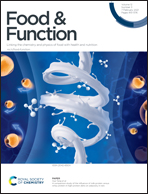Extruded coffee parchment shows enhanced antioxidant, hypoglycaemic, and hypolipidemic properties by releasing phenolic compounds from the fibre matrix
Abstract
The dietary fibre and phenolic contents and the functional properties of extruded coffee parchment flour were studied to evaluate its possible use as an ingredient rich in dietary fibre (DF) with potential antioxidant, hypoglycaemic and hypolipidemic properties in extruded products. Coffee parchment flour treated at 160–175 °C and 25% moisture feed showed higher DF (84.3%) and phenolic contents (6.5 mg GAE per g) and antioxidant capacity (32.2 mg TE per g). The extrusion process favoured the release of phenolic compounds from the fibre matrix. Phytochemicals liberated during in vitro simulated digestion exhibited enhanced antioxidant capacity and attenuated reactive oxygen species in intestinal cells (IEC-6). However, the physicochemical and techno-functional properties were just affected by extrusion at high temperature, although extruded coffee parchment flours exhibited lower bulk density and higher swelling capacity than non-extruded ones. Extruded coffee parchment preserved the glucose adsorption capacity and enhanced the α-amylase in vitro inhibitory capacity (up to 81%). Moreover, extruded coffee parchment maintained the ability to delay glucose diffusion and exhibited improved capacity to retard starch digestion in the gastrointestinal tract. The extrusion of coffee parchment flours preserved the cholesterol-binding ability and augmented the capacity of this ingredient to bind bile salts, favouring the inhibition of pancreatic lipase by coffee parchment. These discoveries generate knowledge of the valorisation of coffee parchment as a food dietary fibre ingredient with antioxidant, hypoglycaemic, and hypolipidemic properties that are enhanced by the release of phenolic compounds from the fibre matrix through the production of extruded products.



 Please wait while we load your content...
Please wait while we load your content...